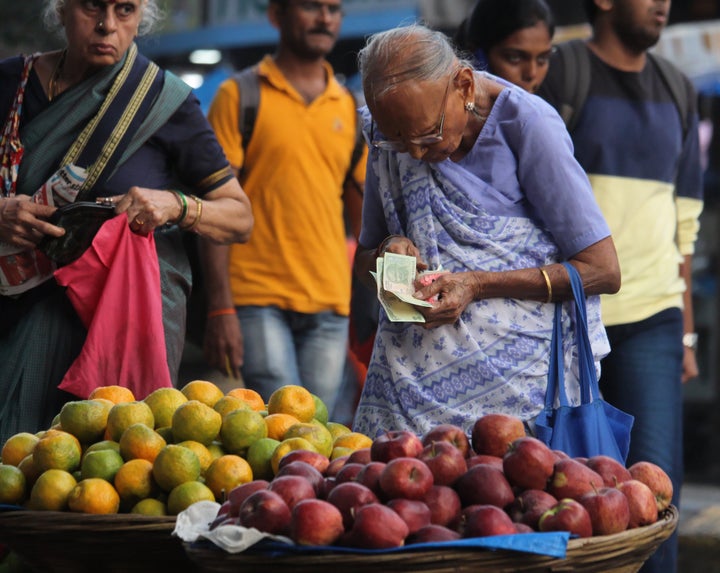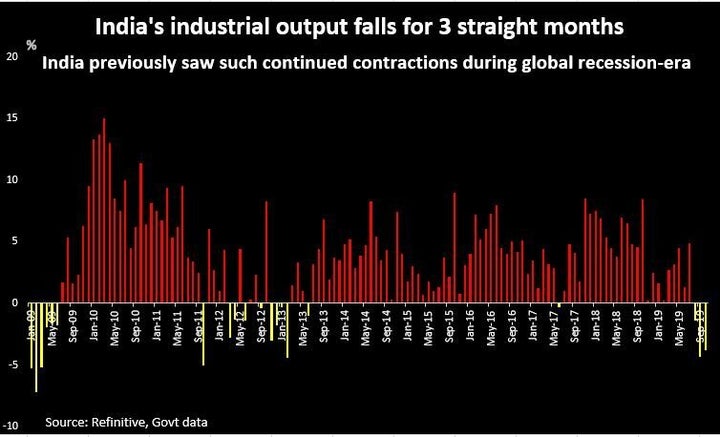
NEW DELHI — India’s retail price inflation in November jumped to a 40-month high, at a time when growth in Asia’s third largest economy has slowed to a six-year low, prompting some economists to warn that the country could be entering into a stagflationary phase.
Annual retail inflation INCPIY=ECI increased to 5.54% last month, faster than the 4.62% rate in October and ahead of 5.26% forecast in a Reuters poll of analysts.
October industrial output fell 3.8% year on year, dropping for the third straight month, with all three major sectors — mining, manufacturing and electricity - shrinking, according to the government data published on Thursday.
This is the first such continued fall in the country’s industrial output since it was hit by the global recession that began in 2008.

“Today’s IIP-CPI mix clearly signals that India is entering into a kind of stagflationary phase,” said Rupa Rege-Nitsure, Chief Economist, L&T Financial Services.
Last month, Former Indian Prime Minister and economist Manmohan Singh had also warned of stagflation, which means lofty inflation amid rising unemployment and stagnant demand. He said, however, that the country had not currently entered stagflation.
This is the second month in a row that retail inflation has remained above the central bank’s medium-term target of 4%.

Increasing inflation and the growth rate slipping to a more than six year low of 4.5% in the July-September period could make policy makers and the Reserve Bank of India walk a tightrope in the coming months.
Already concerns on the inflation front prevented the Reserve Bank of India from cutting its key lending rate for the sixth straight time earlier this month, despite slashing its growth rate forecast for 2019-20 to 5%, which would be the lowest since the 2008 financial crisis.
Various measures from Prime Minister Narendra Modi-led government like cutting corporate tax rate and incentivising commercial banks to pump in liquidity into the struggling shadow banking industry has not yielded results.
In July-September period India’s growth continued to slide and came at a six year low of 4.5%.
The government is also considering more stimulus for the economy but that could mean widening its fiscal deficit as tax revenue collection has remained weak and some estimates suggest a shortfall of over 2 trillion rupees in collections in 2019-20.
WEAK DEMAND
Four analysts estimated November core inflation, which strips off food and fuel prices to reflect the demand in the economy, remained flat at 3.40%-3.6% against 3.44%-3.60% in October.
Weak demand is reflected in the power, fuel, real estate and sales of vehicles, which have resulted in hundreds of thousands of job losses in some industries.
India’s power demand rose 1.2% in the eight months that ended in November, with consumption falling for four months straight, signalling a worsening industrial slowdown that has already stifled economic growth.
Diesel consumption, a barometer of industrial activity, grew 1% between April and November, government data shows. Demand for the fuel had grown 3% during the year that ended in March.
Domestic passenger vehicle sales fell in November for the 13th consecutive month with no sign of an immediate recovery.
Economists expect RBI to continue to hold its key interest rate in February due to rising inflation, which would mean the onus of reviving growth would be on the government that is expected to present the budget in the same month.
“With the likely bottoming of growth and elevated inflation as well as concerns on large fiscal slippages, the policy rate (by RBI) may remain on hold in FY20,” said Sujan Hajra, chief economist at Anand Rathi Securities.
Retail food prices, which make up nearly half of India’s inflation basket, increased 10.01% in November from a year earlier, against 7.89% in October.
Food inflation rose sharply as unusually heavy rains at the end of the monsoon season hit crop yields and caused a spurt in prices of vegetables such as onions.
